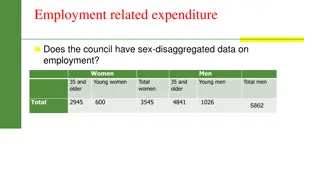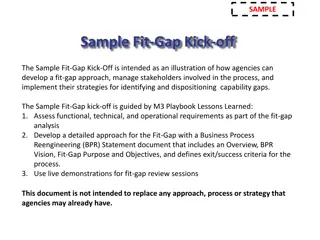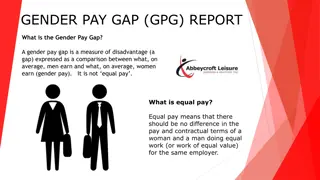
Exploring the Disparity in US and European Loan Rates
Uncover the pricing puzzle between US and European loan rates, delving into syndicated loans from 1992-2002 and the impact of factors like limited competition and lender bias. Analyze motivations, including the importance of the syndicated loan market and insights from Carey and Nini's findings. Investigate various lines of attack focusing on loan types, market dynamics, and institutional influences, shedding light on the complex pricing structures and selection effects that contribute to the rate gap.
Uploaded on | 2 Views
Download Presentation

Please find below an Image/Link to download the presentation.
The content on the website is provided AS IS for your information and personal use only. It may not be sold, licensed, or shared on other websites without obtaining consent from the author. If you encounter any issues during the download, it is possible that the publisher has removed the file from their server.
You are allowed to download the files provided on this website for personal or commercial use, subject to the condition that they are used lawfully. All files are the property of their respective owners.
The content on the website is provided AS IS for your information and personal use only. It may not be sold, licensed, or shared on other websites without obtaining consent from the author.
E N D
Presentation Transcript
Mind the Gap: The Difference between US and European Loan Rates Presenter:AnthonySaunders (NYU) Authors: Tobias Berg (Bonn), Anthony Saunders (NYU), Sascha Steffen (ESMT), Daniel Streitz (Bonn) Warsaw, 27April 2017
Motivation: Pricing puzzle Pricing puzzle by Carey and Nini (JF 2007): Loan spreads in Europe about 20% smaller than in the U.S. Significant implications: Corporate finance, Macroeconomics, Competitionpolicy Data: Syndicated loans 1992-2002 No explanation:creditrisk,loan or borrower characteristics Suggested explanation: Limited competition in the U.S. coupled withhome bias of lenders
Motivation: Carey/Nini pricing puzzle Carey/Niniresults arerobust to: Controls (rating, year, loan characteristics, loan type, loan purpose,industries,government ownership of firms) USD-denominated vs. full sample Pre-1998vs. Post-1999 (beginningof Euro) Differentstandardsby ratingagencies Legal regime / Bankruptcy regimes / Loss given defaults Ex-post monitoring Existenceof state-owned and cooperative banks Tax effects Liquidityeffects
Linesof attack 1. Loan type / Fees: Term loans (1/3) versus credit lines (2/3) Disbursement of full loan amount versus contingent liquidity: complex pricing structure of credit lines 2. Bank vs. bond market Europe: bank-based economy (300%/100%bank-assets to GDP) Implies potential selection effects in syndicated loan markets 3. Institutional investors: Competition from non-bank lenders, in particular for term loans 4. Supply of loans by foreign banks Pre-view: Credit lines: No pricing puzzle, only different pricing structure Term loan: Selection effect explains ~50% of pricing puzzle, institutional investors and foreign bank loan supply removed puzzle until 2007, and explains variation in puzzle over entire period
Data Data sources Dealscan Ratings from S&P (Compustat) Data filters (as in Cary/Nini) Rated firms only (i.e., firms with an objective measure of credit risk) Only loans to US and European firms Sample period 1992-2002 Extended to 2014
Fees: Example Meredith Corp, 16Jun2010,3-year USD 150mn credit line Upfront fee: 50bps $0.75mn Undrawn amount Drawnamount Spread: 250 bps CommitmentFee: 37.5bps upto $0.6mn p.a. up to $3.7mn p.a. AISU AISD 13
The Pricing Strucutre puzzle New puzzle: Why is pricing structure different in U.S. vs. Europe? Two observations High AISD / Low AISU contract ( U.S.-type ) provides disincentives to draw down the line Usage of credit lines is more cyclical in the U.S. (higher sensitivity of usage rates to performance) Idea: U.S. lenders need to shield themselves from draw-downs in bad times
Post-issuance performance: Europe vs. U.S. (univariate) Falling angels U.S.investment grade term loans: 0.5 notches worse rating devlopment on average relative to Europeanborrowers
Line of attack 3: Institutional investors and foreign bank lending
Conclusion Creditlines Accounting for unused fees (AISU) fully explains the pricing puzzle for lines of credit. While European borrowers pay a significantly lower AISD, they also pay a significantly higher AISU. Rationale for differences in pricing structure: Cyclicality of draw-down rates Term loans Selection effects due to larger (junk) bond market in the U.S. Institutional demand pressure since 2002 removed pricing gap Institutional and foreign bank supply associated with variations in loan pricing difference between U.S. and Europe

![[PDF⚡READ❤ONLINE] Zen Mind, Beginner's Mind: 50th Anniversary Edition](/thumb/20459/pdf-read-online-zen-mind-beginner-s-mind-50th-anniversary-edition.jpg)




















